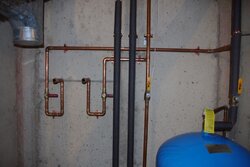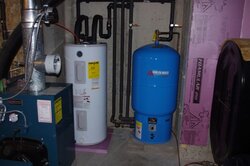(I thought it would be better to start a new thread.)
Should the cold inlet of the elec. wh come from the indirect hot water? Maybe it would pay, to preheat the water the same temperature as the outdoor reset say when a heating zone is on? The boiler would be up to temp anyway, so what's the big deal in heating up the indirect? I'd have to figure out how to wire that up. The reset isn't that much because I didn't think it was a good idea to go too low. Maybe the excess boiler heat could be scavanged (not sure about the whole condensation thing though - how low to go.)
Thinking about it some more, if I did that, both tanks would wind up being heated up, and there'd be standy losses from both. Maybe wiring the the indirect to only run when heat is on would not cost much incremental oil so that it wouldn't be a big deal. The water in the electric would be used first and replaced by warm water from the indirect, so it wouldn't have to run as much.
Maybe plumb it for flexibility in plans, but more complicated than just going whole hog with the electric.
Ideas?
Should the cold inlet of the elec. wh come from the indirect hot water? Maybe it would pay, to preheat the water the same temperature as the outdoor reset say when a heating zone is on? The boiler would be up to temp anyway, so what's the big deal in heating up the indirect? I'd have to figure out how to wire that up. The reset isn't that much because I didn't think it was a good idea to go too low. Maybe the excess boiler heat could be scavanged (not sure about the whole condensation thing though - how low to go.)
Thinking about it some more, if I did that, both tanks would wind up being heated up, and there'd be standy losses from both. Maybe wiring the the indirect to only run when heat is on would not cost much incremental oil so that it wouldn't be a big deal. The water in the electric would be used first and replaced by warm water from the indirect, so it wouldn't have to run as much.
Maybe plumb it for flexibility in plans, but more complicated than just going whole hog with the electric.
Ideas?




